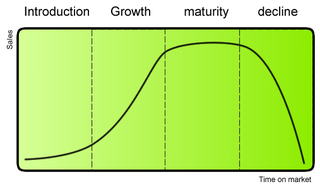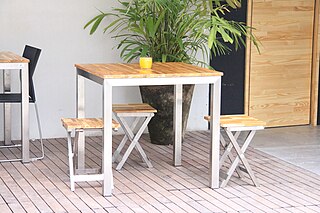Related Research Articles
Rapid application development (RAD), also called rapid application building (RAB), is both a general term for adaptive software development approaches, and the name for James Martin's method of rapid development. In general, RAD approaches to software development put less emphasis on planning and more emphasis on an adaptive process. Prototypes are often used in addition to or sometimes even instead of design specifications.

Product life-cycle management (PLM) is the succession of strategies by business management as a product goes through its life-cycle. The conditions in which a product is sold changes over time and must be managed as it moves through its succession of stages.

Life cycle assessment (LCA), also known as life cycle analysis, is a methodology for assessing environmental impacts associated with all the stages of the life cycle of a commercial product, process, or service. For instance, in the case of a manufactured product, environmental impacts are assessed from raw material extraction and processing (cradle), through the product's manufacture, distribution and use, to the recycling or final disposal of the materials composing it (grave).
Eco-efficiency refers to the delivery of goods and services to meet human needs and improve quality of life while progressively reducing their environmental impacts of goods and resource intensity during their life-cycle.

Green building refers to both a structure and the application of processes that are environmentally responsible and resource-efficient throughout a building's life-cycle: from planning to design, construction, operation, maintenance, renovation, and demolition. This requires close cooperation of the contractor, the architects, the engineers, and the client at all project stages. The Green Building practice expands and complements the classical building design concerns of economy, utility, durability, and comfort. Green building also refers to saving resources to the maximum extent, including energy saving, land saving, water saving, material saving, etc., during the whole life cycle of the building, protecting the environment and reducing pollution, providing people with healthy, comfortable and efficient use of space, and being in harmony with nature. Buildings that live in harmony; green building technology focuses on low consumption, high efficiency, economy, environmental protection, integration and optimization.’
Green marketing is the marketing of products that are presumed to be environmentally safe. It incorporates a broad range of activities, including product modification, changes to the production process, sustainable packaging, as well as modifying advertising. Yet defining green marketing is not a simple task where several meanings intersect and contradict each other; an example of this will be the existence of varying social, environmental and retail definitions attached to this term. Other similar terms used are environmental marketing and ecological marketing.

Cradle-to-cradle design is a biomimetic approach to the design of products and systems that models human industry on nature's processes, where materials are viewed as nutrients circulating in healthy, safe metabolisms. The term itself is a play on the popular corporate phrase "cradle to grave", implying that the C2C model is sustainable and considerate of life and future generations—from the birth, or "cradle", of one generation to the next generation, versus from birth to death, or "grave", within the same generation.

Life-cycle engineering (LCE) is a sustainability-oriented engineering methodology that takes into account the comprehensive technical, environmental, and economic impacts of decisions within the product life cycle. Alternatively it can be defined as “sustainability-oriented product development activities within the scope of one to several product life cycles.” LCE requires analysis to quantify sustainability, setting appropriate targets for environmental impact. The application of complementary methodologies and technologies enables engineers to apply LCE to fulfill environmental objectives.
Design for the environment (DfE) is a design approach to reduce the overall human health and environmental impact of a product, process or service, where impacts are considered across its life cycle. Different software tools have been developed to assist designers in finding optimized products or processes/services. DfE is also the original name of a United States Environmental Protection Agency (EPA) program, created in 1992, that works to prevent pollution, and the risk pollution presents to humans and the environment. The program provides information regarding safer chemical formulations for cleaning and other products. EPA renamed its program "Safer Choice" in 2015.
Product-service systems (PSS) are business models that provide for cohesive delivery of products and services. PSS models are emerging as a means to enable collaborative consumption of both products and services, with the aim of pro-environmental outcomes.

Ecological design or ecodesign is an approach to designing products and services that gives special consideration to the environmental impacts of a product over its entire lifecycle. Sim Van der Ryn and Stuart Cowan define it as "any form of design that minimizes environmentally destructive impacts by integrating itself with living processes." Ecological design can also be defined as the process of integrating environmental considerations into design and development with the aim of reducing environmental impacts of products through their life cycle.
Whole-life cost is the total cost of ownership over the life of an asset. The concept is also known as life-cycle cost (LCC) or lifetime cost, and is commonly referred to as "cradle to grave" or "womb to tomb" costs. Costs considered include the financial cost which is relatively simple to calculate and also the environmental and social costs which are more difficult to quantify and assign numerical values. Typical areas of expenditure which are included in calculating the whole-life cost include planning, design, construction and acquisition, operations, maintenance, renewal and rehabilitation, depreciation and cost of finance and replacement or disposal.

Sustainable packaging is the development and use of packaging which results in improved sustainability. This involves increased use of life cycle inventory (LCI) and life cycle assessment (LCA) to help guide the use of packaging which reduces the environmental impact and ecological footprint. It includes a look at the whole of the supply chain: from basic function, to marketing, and then through to end of life (LCA) and rebirth. Additionally, an eco-cost to value ratio can be useful The goals are to improve the long term viability and quality of life for humans and the longevity of natural ecosystems. Sustainable packaging must meet the functional and economic needs of the present without compromising the ability of future generations to meet their own needs. Sustainability is not necessarily an end state but is a continuing process of improvement.

Eco-costs are the costs of the environmental burden of a product on the basis of prevention of that burden. They are the costs which should be made to reduce the environmental pollution and materials depletion in our world to a level which is in line with the carrying capacity of our earth.
Environmental informatics is the science of information applied to environmental science. As such, it provides the information processing and communication infrastructure to the interdisciplinary field of environmental sciences aiming at data, information and knowledge integration, the application of computational intelligence to environmental data as well as the identification of environmental impacts of information technology. The UK Natural Environment Research Council defines environmental informatics as the "research and system development focusing on the environmental sciences relating to the creation, collection, storage, processing, modelling, interpretation, display and dissemination of data and information." Kostas Karatzas defined environmental informatics as the "creation of a new 'knowledge-paradigm' towards serving environmental management needs." Karatzas argued further that environmental informatics "is an integrator of science, methods and techniques and not just the result of using information and software technology methods and tools for serving environmental engineering needs."
An Environmental Product Declaration (EPD) is defined by International Organization for Standardization (ISO) 14025 as a Type III declaration that "quantifies environmental information on the life cycle of a product to enable comparisons between products fulfilling the same function." The EPD methodology is based on the Life Cycle Assessment (LCA) tool that follows ISO series 14040.
EcoProIT is a project initiated at Chalmers University of Technology at the department of Product and Production Development. The project aims to provide production engineers a tool for detailed ecological footprint analyses, which are becoming more important in terms of marketing and legislation. A published report by MIT in 2011 showed companies thought that environmental sustainable strategy is, or will be, vital to be competitive. The report included many sectors, e.g. covering medicals, automobiles and consumer products. EcoProIT will design a tool for industrial applications used for detailed environmental footprint analyses of their production systems and the products produced using simulation. The tool will simulate the production and analyze the product's environmental footprint in a standardized way. It will also be possible to use the tool for bench marking between different sites. The aim for the tool puts high requirements on standardized methods and data management.
Henrik Wenzel is a Danish engineer and head of SDU Life Cycle Engineering at University of Southern Denmark (SDU).

Rainer Grießhammer is a German chemist and member of the executive board of the Oeko-Institut.
Environmental systems analysis (ESA) is a systematic and systems based approach for describing human actions impacting on the natural environment to support decisions and actions aimed at perceived current or future environmental problems. Impacts of different types of objects are studied that ranges from projects, programs and policies, to organizations, and products. Environmental systems analysis encompasses a family of environmental assessment tools and methods, including life cycle assessment (LCA), material flow analysis (MFA) and substance flow analysis (SFA), and environmental impact assessment (EIA), among others.
References
- ↑ Arno Cahn (30 January 1994). Proceedings of the 3rd World Conference on Detergents: Global Perspectives. The American Oil Chemists Society. pp. 62–. ISBN 978-0-935315-52-3.
Indeed, the broad view provided by an LCA reveals strengths and weaknesses in comparison to competing or potential substitutes. ... This is the exact purpose of a new Brussels-based coalition, created a year ago, under the name of Society for the Promotion of LCA Development (SPOLD). The science base of the LCA methodology cannot be compromised because it needs ...
- ↑ Bhaskar Nath (1998). Environmental Management in Practice: Instruments for Environmental Management. Psychology Press. pp. 213–. ISBN 978-0-415-14906-8.
Notably, the Society for the Promotion of LCA Development (SPOLD), whose membership includes large industrial companies, has been funding research projects on LCA. One of the specific aims of SPOLD is to design a common format for ...
- ↑ Zacharias Agioutantis (2003). Book of proceedings. Heliotopos Conferences. pp. 135–. ISBN 978-960-87054-2-5.
The development of LCA methodology in Europe has been further promoted by the Society for the Promotion of LCA Development (SPOLD) and a number of EU initiatives such as the European network for strategic life-cycle assessment ...
- ↑ David H.F. Liu; Bela G. Liptak (26 February 1999). Environmental Engineers' Handbook on CD-ROM. CRC Press. pp. 126–. ISBN 978-0-8493-2157-3.
The Society for the Promotion of LCA Development (SPOLD), founded in 1992 and based in Brussels. Its members are companies who support LCA as a decision making tool. SPOLD is conducting a feasibility study on creating a database of ...
- ↑ Claude Fussler (1996). Driving Eco-innovation: A Breakthrough Discipline for Innovation and Sustainability . Pitman Publishing. ISBN 978-0-273-62207-9.
David Russell spends much of his time grappling with such issues and helping resolve them through involvement with SPOLD (the Society for the Promotion of LCA Development). He sees a need for new techniques to communicate LCA data ...
- ↑ Weidema, Bo. 'SPOLD @ 2.-0 LCA Consultants'. Lca-net.com. N.p., 2015. Web. 5 Nov. 2015.